
The Truth About Wine Glasses
There is a mythos surrounding wine which suggests that specialized knowledge or equipment is required to get the most out of it. This may be reinforced by the slightly less true admonition that "you get what you pay for" with wine, and so expect to start shilling out the bucks. Just as you don't need a fortune to buy a wine you enjoy, you don't need to spend an inordinate amount on wine glasses. Unless, in both cases, you want to.
A glass comparison is one of the staples of my wine school. For most other tastings I go out of my way to keep it as blind, and as objective as possible. Barring some sort of elaborate machine that would handle the glass for you while you were blindfolded, this is simply a experiment that is too difficult to conduct blind. In some ways this is appropriate as the feel and overall subjective experience of a wine glass is paramount.
Buy them if you love them, not because they are the "right" glasses
What little empirical evidence I have managed to collect from these tastings suggest that shape is more important than material. Crystal feels better in your hand than glass, but does not appreciably improve the aromas or flavors. We have even had acrylic versions of the popular shapes, to use around a pool, and while they do not stand up to their glass counterparts, the acrylic ones are better than glass glasses that are the wrong shape.
Much has been made by those trying to sell you their stemware about the perfect glass for any given wine. This is easier to test by simply using them with the suggested wine and undisclosed others. I have had limited opportunity to conduct this test, but thanks to a few open minded producers, I have done it more than twice. Never has the suggested wine done appreciably better in its designated glass than other wines.
Applying skepticism to the concept you have to assume anyone selling you something has an interest in telling you it works. Within any given "type" of wine there is enough variation that you have to question how a single glass shape could be ideal for all of them. I am not saying don't buy these glasses, I am saying buy them if you love them, not because they are the "right" glasses.
Life, and wine glasses are full of compromises
The ultimate extension of specialized wine glass shapes has given rise to tasting glasses that are designed to show off faults in the wine. Great for tasting, lousy for drinking out of. I used variations of these glasses myself for most of my career. My recommendation for professionals tasters is to always use the same shaped glass, to reduce variables.
What does make a wine glass good or bad? The ability to swirl the wine without wearing it, and a small enough mouth that the aromas don't easily escape. In one form or another every successful wine glass I have used follows this principal. All of these wine glasses are designed to be filled to the widest point, no more. This allows you to swirl, and gives the lighter components in the wine plenty of headspace in the glass to mix with air.
Red Wine Glass
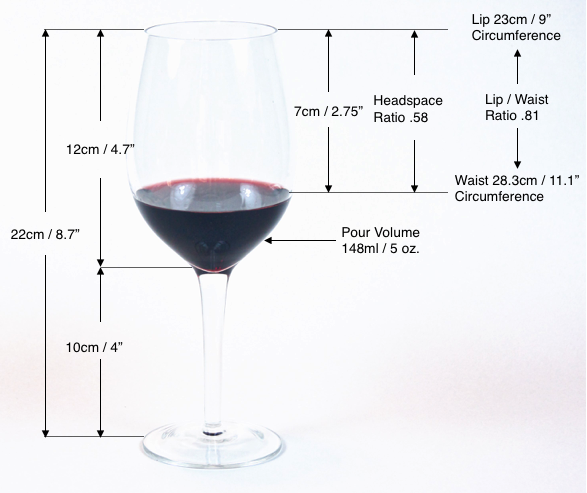
The traditional red wine glass is taller than a traditional white wine glass, but is otherwise shaped the same way. The larger glass allows more headspace in the glass, in comparison to the amount of wine, for better or worse. In our tests the red wine glass always did well, but never the best, for all types of wine (red, white, sparkling, sweet).
Pros: Looks tall and elegant. Decent for aromas and taste. Holds a good sized pour.
Cons: Easy to tip over. Not the top contender for aromas and flavors. May hold too much wine if you are drinking something chilled (it will warm before you finish the glass).
White Wine Glass
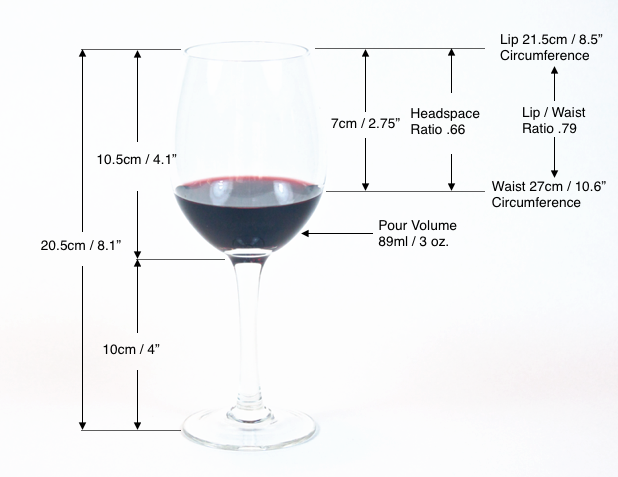
Shown with red wine for contrast, this white wine glass is made by the same producer as the red, and so is in many ways just a shorter version, but the ratio of the widest part (the waist) to the mouth is improved in the smaller version. This may account for its higher ranking for aromas and flavors than the larger red wine glass. It is especially popular among my tasters for sparkling wine, for those who prize aroma over mouthfeel.
Pros: Looks great next to its larger brother. This is especially important if you have more than one kind of glass on your table setting. A favorite for aromas and flavors. More stable than the taller version. Smaller pour keeps wine from warming before it is finished.
Cons: Smaller pour means more frequent refilling. Not as impressive as larger glass.
Restaurant "Wine by the Glass" Glass
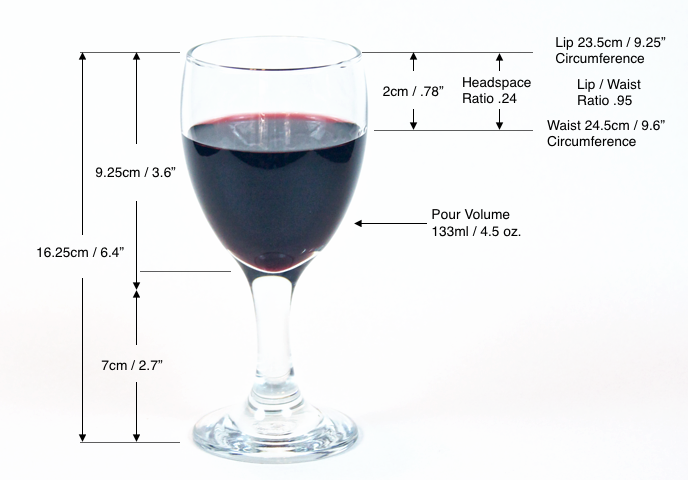
This sturdy glass is common in restaurants because it is hard to break or knock over. Upscale restaurants often distinguish themselves simply by eschewing this classic but none the less worthless glass. With no room to swirl it is impossible to get the full wine experience. One of the reasons that restaurants often opt for this shape is that many customers expect a glass of wine to be filled to the top. While this glass filled up does quite hold the same pour as a red wine glass, the relative emptiness of the red wine glass makes it look like less, thus upsetting some customers.
Pros: Hard to break, can fill it to the top.
Cons: Awful for aromas and flavors. Guaranteed to stain your favorite clothes if you try to swirl. No better than a jelly jar, and maybe not that good.
INAO Glass
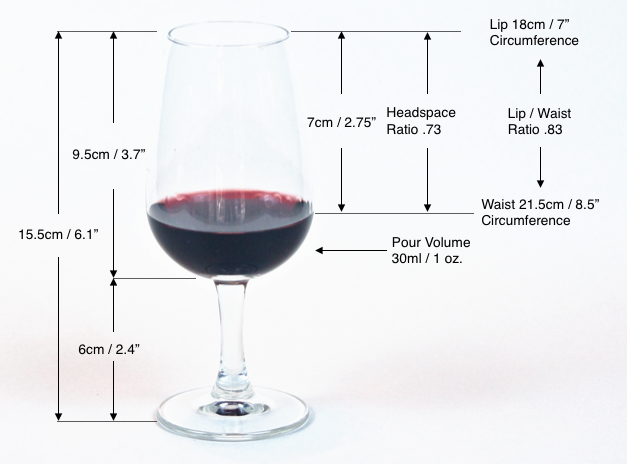
This is the official wine tasting glass for most of the world. It holds very little so it is not necessarily a great drinking glass, but it is perfect for tasting. Tops for aromas for every kind of wine, including sparkling. Small enough to store plenty of them - I have 144 - and when you are not using them for tastings, they work great for parties. Sturdy, hard to knock over, and usually well priced. If you are a wine professional you need this glass, and should consider always taking it to every tasting. Tasting out of a standardized glass means that you don't have to take the glass into consideration at all.
Pros: Standard for all official tastings, the world over. Holds a small amount, ideal for tasting several wines, or larger groups. Great for aromas and flavors. Usually well priced.
Cons: Holds a fraction as much as other glasses. May be too small for some people to comfortably drink out of.
Sparkling Wine
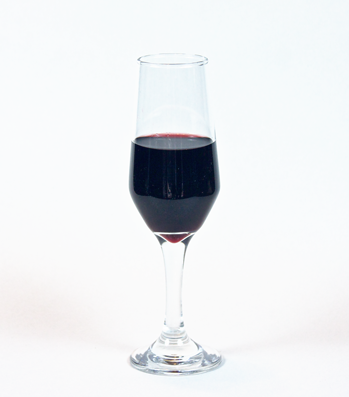
The quick answer is that flutes (like the one shown above with red wine in it for contrast) are better for those that consider the mouthfeel of the sparkling wine to be critical. A white or even red wine glass is better for those who enjoy the aromas of sparkling wine. With an increasing number of vineyard designate and other artisanal sparkling wines coming to market, there is more reason to think about enjoying your sparkling wine from a larger glass. Whatever you do, avoid those Marie Antoinette shaped "sherbet" or "saucer" style glasses for sparkling wine. They are even worse than the restaurant glass above.
Note: Notice that the glass above is not filled to the top. You don't want to put too much sparkling wine in a glass at a time, as it is best enjoyed cold.
Port and other Dessert Wines
I don't have a picture of a port or dessert wine glass, because there should be no such thing. These are not only wines, but some of the greatest and most expensive wines in the world, and therefore should be served in your best wine glasses. It is an all too common sin for a restaurant to sell you a great wine like a $75 glass of 40 year old Tawny Port in a tiny glass that is aptly named a liqueur glass. Wine should go in a wine glass. I don't even like my amaretto or sambuca in such a small glass. As far as I am concerned they are a waste. Ask nicely for a better glass to pour it into.
Summary
Cheaper glasses go into the dishwasher and are harder to break. More expensive glasses feel better in your hand, and are a noticeable luxury. What is important is that the glass capture the aromas, allows you to see the wine, and makes it easy to swirl. Nearly everything else is personal preference.
I usually have many shaped glasses because I regularly serve 5 wines at a time to my guests. The different shapes makes it easier to tell them apart. If I was going to pick a single all around stemmed glass that had to do multiple duty, I would probably go for a brandy snifter. It is a great shape, feels good in the hand, and works for everything.
A quick note about the new breed of stemless glasses. They are hard to knock over since the wobble but don't fall down. The lack of stem means fingerprints on the glass and warming of the wine, especially if you are not sitting down. It also means they don't fit in a stem rack. Other than that, the shape is usually good for swirling and aromas.
Life, and wine glasses are full of compromises. You don't have to spend a lot, but you can. Just keep in mind that they are all fragile, so when they do hit the ground, make sure the glass breaks, and not your budget.
Copyright WineEducation.com
Do not reprint without permission